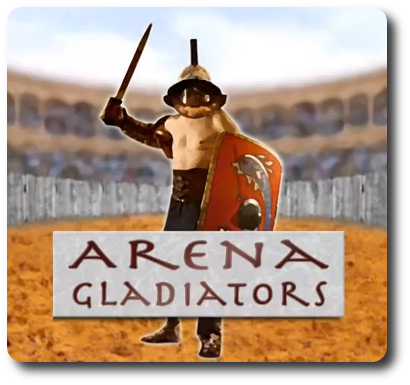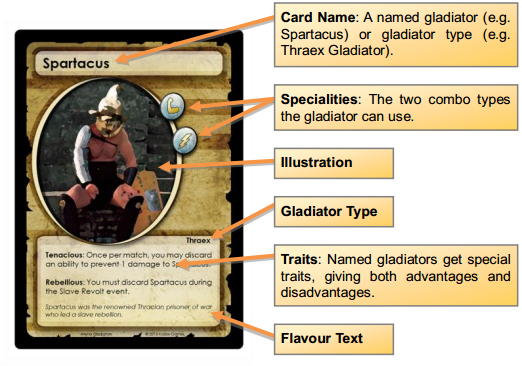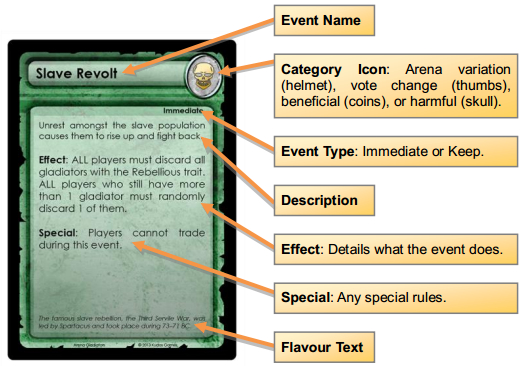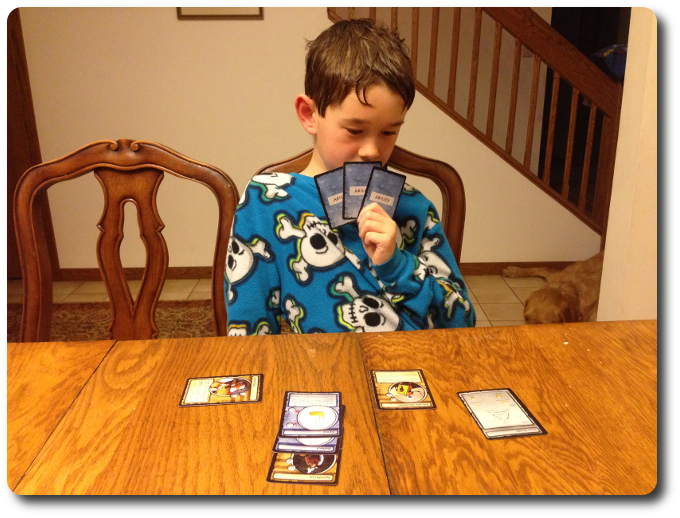
The Basics:
- For ages 9 and up (publisher suggests 12+)
- For 2 to 4 players
- Approximately 60 minutes to complete
Geek Skills:
- Counting & Math
- Logical & Critical Decision Making
- Reading
- Pattern/Color Matching
- Strategy & Tactics
- Risk vs. Reward
- Hand/Resource Management
Learning Curve:
- Child – Easy
- Adult – Easy
Theme & Narrative:
- Become the greatest gladiator trainer in Rome!
Endorsements:
- Gamer Geek mixed!
- Parent Geek mixed!
- Child Geek approved!
Overview
You are the owner and trainer of gladiators. You have fought in the arena yourself, killed and survived. You were awarded your freedom and your future. Now you spend your days training the next generation of gladiators to fight ruthlessly and die bravely. The sun has risen and the arena is filling with spectators eager to watch life and death play out before them. Today men will die and legends will be born.
Arena Gladiators, designed by Simon Beal and published by Kudos Games via the Game Crafter, is comprised of 29 Event cards, 20 Gladiator cards, 40 Ability cards, and 1 Quick Reference card. The cards are made of standard cardstock. What little artwork there is on the cards is clean and compliments the game’s theme. Not included with the game, but necessary to play, is some sort of means to keep track of players’ victory points. I suggest a single six-sided die per player.
Game Set Up
To set up the game, first sort the cards into three different decks. When completed, you will have 1 Gladiator deck, 1 Abilities deck, and 1 Events deck.
Second, remove all the core abilities from the Ability deck. Core abilities have a star icon on the card’s top right corner face. Deal 1 type of each core ability to each player (“Bash”, “Block”, “Maneuver”, and “Strike”). Any remaining core Ability cards are removed for the duration of the game.
Third, shuffle the Gladiator, Ability, and Event decks separately. Place each deck, face-down, in a row in the middle of the playing area. Make sure each deck has enough space for its own discard pile.
Fourth, each player is dealt 3 Gladiator cards and 3 Ability cards. The player’s gladiators should be placed in front of them, face-up. The Ability cards should be kept hidden from opponents until played.
That’s it for game set up. Time to fight!
Professional Fighters
The Gladiator cards represent individuals trained in the art of combat. Each gladiator has been specially trained to use specific weapons and techniques, making each gladiator unique. Specialties are used in combo attacks and traits determine advantages and disadvantages that must be overcome and taken advantage of.

Of War and Fortune
Arena Gladiators is played in turns with no set number of turns per game. A player’s turn consists of 4 phases which are summarized here.
Phase 1: Event
Rome is a place of splendor, wonder, and unrest. The Event cards will impact a player’s turn immediately or later in the game when it’s advantageous. The first thing a player does on their turn is flip over and reveal the top-most Event card from the Event draw deck. Players should NOT read them out loud until they determine the Event card type. The types follow.
- Immediate: These Event cards are immediately resolved and placed in the Event discard pile. The player should read them out loud, take the necessary actions, and continue to the next phase of their turn.
- Keep: These Event cards are placed in the player’s hand and not announced to the rest of the table. These types of Event cards can be used during the player’s current and future turns were applicable.

Note: If the Event draw deck is ever exhausted, shuffle the Event discard pile to create a new deck.
Phase 2: Arena
The player selects one of their Gladiator cards to fight any other opponent. The player does not get to decide which of the opponent’s gladiators will enter the arena.
Challenges can be refused. If it is, the player can challenge another opponent or the same opponent using a different gladiator. If all the opponents with at least one uninjured gladiator refuse to accept the player’s challenge, the player automatically earns 1 victory point. The player is also not required to challenge an opponent if their gladiators are currently hurt and healing.
Phase 3: Combat
Combat only occurs if the player’s challenge has been accepted. The player’s selected gladiator now goes toe-to-toe with the opponent’s selected gladiator.
Combat is divided into rounds. Each round is comprised of 7 steps.
Step 1: Choose Abilities’
Each player secretly selects 1 Ability card in their hand and places it face-down next to their attacking gladiator card indicating they are ready for the next step in combat. There are 4 different types of attacks. Each attack type beats another (much in the same way as Rock-Paper-Scissors).
- Speed (beats Accuracy)
- Accuracy (beats Might)
- Might (beats Speed)
- Defense (beats Speed, Accuracy, and Might)

There might also be a combo effect listed, which I will go over in more detail in just a moment.
Step 2: Reveal Abilities
Each player reveals their Ability card by flipping it over.
Step 3: Attack Resolution
Each player now looks to see which gladiator landed a blow. This is done by comparing the attack types. If the player’s attack type is not blocked by their opponent’s selected Ability card, the opponent’s gladiator takes 1 point of damage. The same goes for the opponent’s unblocked attacks, but don’t record damage yet…
Step 4: Combo Resolution
Some Ability cards list a combo effect. These are triggered ONLY if the following is true.
- The gladiator has the same specialty listed as the attack type listed on the combo.
- At least 1 Ability card is in the player’s combo pile (not including the current Ability card being played).
If the combo is triggered, the effects are resolved immediately unless the term “may” is included in the combo’s description. Any damage inflicted by the combo is resolved during the next step. A combo’s effect is capable of being triggered regardless if the gladiator inflicted damage or not.
Step 5: Damage Dealing
Damage is kept track of by rotating the gladiator card 90 degrees clockwise for each point of damage it takes. If a gladiator takes 2 points of damage, it’s defeated.

Note that the Defense attack type can never be defeated by Speed, Accuracy, or Might. However, Defense does not inflict damage on the opponent.
Step 6: Defeat Check
If a Gladiator card has been rotated 180 degrees (upside down) it’s defeated, but not killed. A vote is now taken and players should feel free to negotiate and debate if they think it’s necessary.
All players either show a thumbs-up (indicating the gladiator should survive) or a thumbs-down (indicating that the gladiator should be killed). In the case of a tie (or only playing with 2 players), draw the top-most Event card. If the skull icon is shown, the gladiator is killed. The revealed Event card is then placed at the BOTTOM of the Event draw deck.
Killed gladiators are placed in the Gladiator discard pile.
Step 7: Combo Pile
The player can now decide if they want to leave their played Ability card next to their gladiator or not. If they decide to not leave it, the Ability card is returned to the player’s hand. If the player doesn’t have any Ability cards and another round of combat will ensue, they MUST take back all their Ability cards.
Any cards left create the gladiator’s combo pile. The combo pile is used when determining if a combo is triggered during step 4. Ability cards can also be left in the combo pile to bluff an opponent into thinking a nasty combo is coming up!
Phase 4: End
Finally, the player completes the following actions after combat has ended. If the player did not engage in combat on their turn, they still complete this phase.
- Heal 1 Gladiator card they own (rotate 1 Gladiator card 90 degrees counterclockwise).
- Draw 1 Gladiator card OR 1 Ability card (not both).
- Discard down to 7 Ability cards (core abilities can NEVER be discarded, but they can be traded).
- Discard down to 3 Gladiators.
- Discard down to 3 “Keep” Event cards.
Players can trade their cards, if they like. If they get a card they can use immediately, they may do so if it makes sense within the game’s defined rules.
Winning the Game
The first player to collect 5 victory points wins the game. If a shorter or longer game is wanted, reduce or increase the number of victory points necessary to win the game.
To learn more about Arena Gladiators, visit the game’s web page.
Prediction
Arena Gladiators doesn’t strike me as a complicated game. The combat is easy, the combos are straightforward, and the way you go about beating your opponent over the head is intuitive. I don’t think we’ll have any problems teaching the game to our diverse group of players. The only aspect of the game that might be an issue is the game’s theme. I have heard several Parent Geeks in the past remark how much they do not like games where violence is at its center. Arena Gladiators is not a gory or bloody game, but there is certainly combat. The vote to “kill” or “spare” the gladiator is going to make some Parent Geeks raise their eyebrows.
For the Child Geeks, I think we’ll see cheers all around. They like card games, especially the kind that lets them act out epic battles. For the Gamer Geeks, I think the game’s repetitive combat and simple Rock-Paper-Scissors mechanic will bore them after a few rounds of play. The need to outsmart your opponent will appeal to them, as will the combos, but little else.
The best way to teach Arena Gladiators is to demonstrate a complete turn. This allows new players to see how all the cards interact and get a general idea of the flow of the game. The combo system might take a bit longer to explain, but I don’t think you’ll encounter too steep of a learning curve. Note that the game does require its players to read.
And so, after teaching the game to my oldest little geek, I asked him his thoughts on Arena Gladiators so far.
“Neat! I like how we get to send in our warriors and decide how they fight!” ~ Liam (age 9)
Glad to hear he is optimistic and enthusiastic! Lets play the game and see if he is still as excited after an hour or so in the arena.
Final Word
The Child Geeks immediately understood how to go about battling each other in the arena. It took 1 game before they were playing their Ability cards to maximize their combos. By their third game, they were a force to be reckoned with. The Child Geeks have played games where cards are used to battle and boost combat before and quickly recognized the best way to go about engaging their opponents. Specifically, Magic: The Gathering and Pokémon was mentioned by the Child Geeks as games they thought helped them learn Arena Gladiators. According to one Child Geek, “What I like most about this game is how I can create combos when I attack. A punch, a kick, and BANG! Clobbering time!” The only aspect of the game the Child Geeks did not enjoy was the game’s overall length. This was easily addressed by reducing the number of victory points the player needed to win. When all the games were over and the dust in the arena had settled, all the Child Geek voted to approve Arena Gladiators.

Round 3 in combat and my little geek and I have yet to land a hit! My son carefully considers his next move…
The Parent Geeks thought the game was easy to learn and fun to play, but not all of them were pleased with the game’s overall theme and narrative. According to one Parent Geek, “I don’t think pitting people, even imaginary ones, in an arena to fight to the death is something to have fun with.” While it’s true that the historical gladiatorial games were violent, bloody, and deadly, many Parent Geeks still enjoyed the game. According to another Parent Geek, “I think the combat is easy and it’s more about out-thinking your opponent than anything else. I also like how the table gets to vote on a gladiator’s fate. That was a nice touch.” When all the games were over, the Parent Geeks were mixed. The deciding factor would appear to have been if the Parent Geek saw Arena Gladiators as just a card game or as an abstract arena of death.
The Gamer Geeks were, for the most part, neither impressed or unimpressed with Arena Gladiators. According to one Gamer Geek, “The mechanics are solid, but the game feels very repetitive. You pick a fight, fight, and then do it again until someone says “Uncle” or you win the battle.” For some of the Gamer Geeks that was enough. According to one Gamer Geek who really enjoyed the game, “I really like this game. It’s easy to learn, fun to play, and very competitive. Thematically, it does a great job of capturing the battles in the arena. I’d play this again without hesitation.” The final vote put Arena Gladiator with a thumb that was neither up or down. Some of the Gamer Geeks liked the game and some thought it was just a mediocre game. It’s worth noting that none of the Gamer Geeks thought Arena Gladiators was a bad game.
Every since I was introduced to Hoplomachus, I’ve had a thing for gladiator themed games. Arena Gladiators is a quick game to set up and can be a quick game to play if you reduce the number of victory points necessary to win. At times, the game did feel rather long. Especially when I played the game with 4 players. The game also tends to grind slowly about midway through when everyone has a good hand of Ability cards. The only thing that upsets a player’s day is an Event card that can cause unavoidable shenanigans. I also found that combos were too easy to use and it didn’t make much sense not to always create combos over and over again. Even if you get hit, you can clobber an opponent if you get your combo out in time.
Despite the quirks, I have enjoyed Arena Gladiators. The game is being positioned as an “expandable” card game, which would imply that there is more to come. I hope, for the game’s sake, it’s not more of the same. If more of the same was added, it would just be that many more cards to shuffle, but not really think about. With just a bit more work and some tightening of the rules, I can easily see Arena Gladiators winning over the Gamer Geek crowd.
If you are looking for an easy to teach and fun to play gladiatorial card game, do take a look at Arena Gladiators.
This game was given to Father Geek as a review copy. Father Geek was not paid, bribed, wined, dined, or threatened in vain hopes of influencing this review. Such is the statuesque and legendary integrity of Father Geek.




Pingback: In Review: Father Geek’s Monthly Newsletter (June 2014) » Father Geek